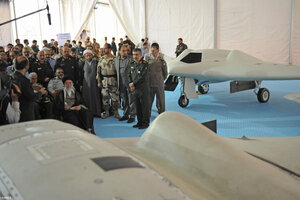Iranians fly knock-off of US stealth drone. Did they get it right?
Iran says its version of the unmanned aerial craft is an improvement on the US-made RQ-170 Sentinel, which it captured three years ago. A Pentagon spokesman says there's 'no way' it matches US technology.

In this picture released by the official website of the office of the Iranian supreme leader, Supreme Leader Ayatollah Ali Khamenei, seated left, listens to an official during his visit at an aerospace exhibition in Tehran, Iran, Sunday, May 11, 2014. The exhibition revealed an advanced CIA spy drone, front, captured in 2011 by Iran, and its Iranian-made copy, back. Khamenei, during the exhibition Sunday, criticized the West for its demands Tehran restrict its missile power, the official IRNA news agency reported. (AP Photo/Office of the Iranian Supreme Leader
Office of the Iranian Supreme Leader/AP
Tehran, Iran
Iran says its reverse-engineered version of the American stealth drone that it captured three years ago is faster, more fuel efficient, and even less detectable by radar than the US original.
A test flight of the drone was announced this week, and Iran broadcast video footage of the flight on Wednesday.
The captured bat-wing RQ-170 Sentinel drone was on a CIA intelligence mission over Iran in December 2011 when it was brought down largely intact in what Iran called an “electronic ambush.”
The footage broadcast on Iran state television shows a very similar drone to the RQ-170 filmed from the ground and the air, flying gracefully against a backdrop of clouds and desert terrain. The landing sequence appears disjointed, leading some analysts to suspect that that portion of the video shows a smaller model touching down.
“The Americans’ mini-stroke will be completed by watching the Iranian RQ-170 [in this video],” said Revolutionary Guard aerospace commander Brig. Gen. Amir Ali Hajizadeh.
The smaller Iranian version can fly longer than the American original “because of its enhanced body,” asserted General Hajizadeh. “The Americans had used metal in the body, but we did not use metal at all. It helps to reduce its detectability by radar.”
Pentagon spokesman Col. Steve Warren downplayed the capability of the Iranian knock-off version, and said there is “no way it matches American technology.”
Iran’s capture of the drone embarrassed Washington, and has been used by Iran to showcase its technical ability – both in sighting and bringing down the drone intact, and in harnessing US surveillance technology that would also be of interest to Russia and China.
An Iranian engineer tasked with decoding the US drone’s memory told The Christian Science Monitor soon after it was captured how Iran had incrementally “spoofed” the drone’s GPS system, causing it to land in Iran instead of its home base in western Afghanistan.
The US military and intelligence community rejects the possibility that Iran “hijacked” the drone electronically. Yet two months before, Iran claimed it had gained such a capability, though it was barely noticed since Iran often exaggerates military advances.
Peculiarity with video is noted
And less than two months before the drone capture, the US military, in order to better cope with hostile electronic attacks, approved two $47 million contracts to make military GPS systems less vulnerable.
The Aviationist specialty website noted one peculiarity with the new Iranian video.
“The footage of the flying drone looks genuine; what seems to be a bit weird is the sequence of the RQ-170 landing on the runway: more than a UAV, the aircraft moves and reacts to the remote pilot’s input as a small remotely piloted scale model,” wrote David Cenciotti.
Since the first prototype shown was built at 60 percent scale, “one might wonder whether the landing drone depicted in the footage is not the full scale replica but the smaller original prototype.” It noted that some frames of the landing video “seem to be computer generated.”
The US military was forced to acknowledge the existence of the state-of-the-art RQ-170 stealth drone program after Iran showed the captured craft on state television, largely intact, its undercarriage hidden by banners with anti-American slogans.
Iran's 'sweet day'
Iran vowed to reverse-engineer the drone and later claimed it had cracked the codes to two hard drives, which it says showed the drone had made 13 flights over Pakistan and Afghanistan. In February 2013, Iran released video from an on-board camera showing the drone landing at a US base in Kandahar, Afghanistan.
Last May, when Iran unveiled its smaller scale replica, Iran’s Supreme Leader Ayatollah Ali Khamenei called it a “sweet day.”
Hajizadeh added to the triumphalist tone at the time: “This was done to take [the Americans] down a peg. That is why we wanted to make one.” He noted, however, that Iran was still learning how to fly and control its replica craft, and was using two smaller versions – one 15 percent scale, another 40 percent, to do so.
Yesterday he said Iran had “many successful flights but also unsuccessful ones, but we got hold of it and managed its flight.” Hajizadeh said Iran plans to deploy four RQ-170 replicas by spring, and called on Iranians to come up with a “good name” for it.

